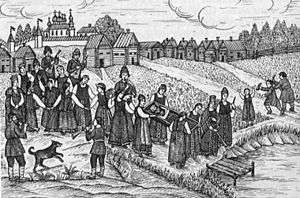Kostroma (deity)

Kostroma (Russian: Кострома́) is an East Slavic fertility goddess. Her name is derived from костёр (kostyor), the Russian word for "bonfire".
The rites of Semik were devoted to her. During this festival a disguised girl or a straw figure portrayed Kostroma. First, a scarecrow was honored and revered. Then, participants of the rite mourned the death of Kostroma, and burned or tore the scarecrow. Rituals with Kostroma were aimed at improving soil fertility.
The scarecrow of Kostroma is part of East Slavic folklore.
Myths about Kostroma
There is a Slavic myth about Kostroma and Kupalo. According to the myth, Kupalo and Kostroma were twins. Their parents were Simargl, the god of fire, and Kupalnitsa, goddess of night. Once, Kostroma and Kupalo ran into a field to listen to songs of birds Sirin, the bird of sorrow, and Alkonost, the bird of joy. Both birds, especially Sirin, were dangerous. The one who listened to the singing of Sirin, forever went into the Nav, the world of the dead. Kostroma listened to the singing of Alkonost, while Kupalo listened to the song of Sirin. And then, by the order of Chernobog, Sirin and gusy-lebedi (The Magic Swan Geese) stole Kupalo and carried him into the Nav[1][2].
Many years later, one day, Kostroma walked the shore of the river Rah and made a wreath. She boasted that the wind would not blown wreath off her head. According to the belief, it meant that she would not marry. This boast was not approved by the gods. The wind become stronger, and wreath was blown by the wind from Kostroma's head and fell into the water, where it was picked up by the Kupalo, who was near by in the boat. According to the Slavic customs, the one who picked up the wreath must necessarily marry the girl who made it. Kupalo and Kostroma fell in love and shortly were married without any knowledge that they were brother and sister. After the wedding, the gods told them the truth. That is why Kupalo and Kostroma committed suicide. Kupalo has jumped into the fire and died, while Kostroma ran to the forest, threw herself into the forest lake and drowned. But she did not die, she became a mavka. Since then, she walks the shores of that lake. If she should see a young man, she immediately seduces him and pulls into the water abbys. When Mavka realises that the young man is not her lover, it is already too late and the young man has already drowned[1][2].
And then, the gods repented, realizing that their revenge was too cruel. But to give Kupala and Kostroma again the human body was impossible, and they turned them into the yellow-blue flower, in which the fiery yellow color was the color of Kupala, and the blue one, like the waters of a forest lake, was the color of Kostroma. The Slavs gave the name Kupalo-da-Mavka (Kupalo-and-Mavka) to the flower. Later, in the time of Christianization in Rus, the flower was renamed to the Ivan-da-Marya (Ivan-and-Marya)[1][2].
See also
References
Sources
- Buynova Tatyana Yuryevna (2008). Myths of the Eastern Slavs (in Russian). Akvilegia. ISBN 978-5-901942-61-1.
- Olga Evgenevna Kryuchkova (2013). Slavic gods, spirits, heroes of bylins (in Russian). ISBN 9785457640436.
- 1 2 3 Buynova Tatyana Yuryevna 2008, p. 256.
- 1 2 3 Olga Evgenevna Kryuchkova 2013, p. 230.